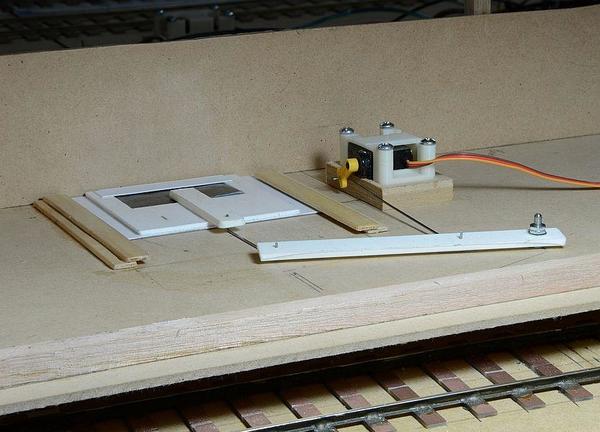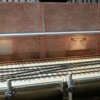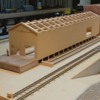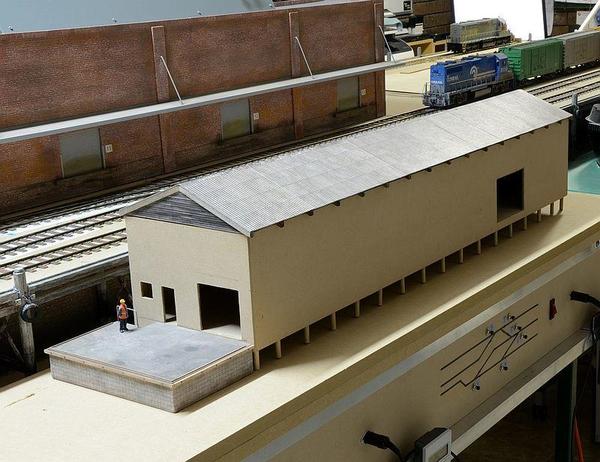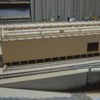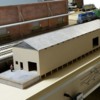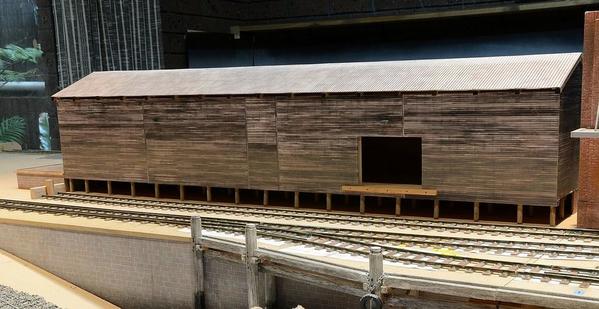Thanks, JP
Thanks, JP.
Here is the completed motley crew ready for inspection . . .
I had to do some fettling on the Kadee couplers with a file to smooth the contact areas, so that they would go together without jamming. I also put a smear of lubricant on them. Now I can push up with the loco on notch 1 and they just glide together.
To uncouple, I just push up, press the coupler release button and back away. Silky. ![]()
Attachments
Fantastic shot! it seems to be 1/1 scale! ![]()
if I understand well, you manage the whole of the layout with the command station (engines, switches, couplers). That's a good idea!
jp
Thanks, JP
Yes. It's all DCC (Lenz). In preparation for the next step - computer control.
The HO layout in the background is computer controlled. There is a video of it on my YouTube page.
I can dig it out for you if you are interested.
Cheers
Yes I am!
email in my profile.
jp
Maybe others will as well.
These were taken before the scenery went on . . .
I hope you don't get bored easily. ![]()
One word: excellent!
Like the sounds of the engines!
jp
Thanks, JP
Now that all eight cars have been fine tuned so that their couplers operate correctly, it's time to start on the buildings.
This one is a warehouse, which hides the turnout motors et al. The mimic panel needs to be on top for operating days.
The doors will be roller doors, which will operate with servos; the same as the turnouts with a Tam Valley RR Octo-controller
The next building will be to its left, and probably gable roofed - probably another warehouse.
They will be in low relief to allow me a street scene with railway tracks behind them.
Cheers
Attachments
Operating doors! wahouuu
The "nec plus ultra"
The tugboat is amazing too!
Great work, Max! ![]()
jp
Thanks, JP
poco a poco
Cheers
The doors are made from 1 mm styrene siding, with a 2 mm plate glued to the back for stiffness. The plate has a space cut into it to take a piece of lead flashing. The lead flashing gives the door extra heft with a lower centre of mass. It is captive in the space.
The door has a pendulum effect, which should help it slide when it's being lowered.
Here is the first assembly in position . . .
The whole mechanism slides freely with light finger pressure, so the servo will have no trouble moving it.
The servos will be controlled by DCC using a Tam Valley Depot™ Octopus 111a™ and an Octocoder™
As the names suggest, they are capable of control of up to eight servos.
In my opinion, the Octos are the best on the market for servo control; having tried quite a few. They give fine adjustments and switch the servos off once they reach the ends of their travels, so they don't buzz. They are simple to program with the Octo 111 Remote.™
I have used them for all of my turnouts on this layout.
Model aircraft servos are quiet - and gentle on turnouts, while still holding the point rails firmly in place.
Cheers
Attachments
Fine work, Max! ![]()
But too hard for me! I don't know anything about programming and servos.....![]() !
!
It's better for me to cut styrene sheets!!!
jp
Thanks, JP
It's not that hard. I had to learn. ![]()
We learn every day; I recently jumped from DC to DCC! and it's a big step for me! I discover day by day the huge possibilities of my little DCC box; it's magic, really!
jp
Here is some more DCC animation stuff by my friend, Laurie McLean . . .
I've run the 12 Volt Regulated DC bus for the lights under the awning and for power for the servo controller, which should arrive from Tam Valley Depot next week.
There is also an aerial wire which will carry the servo leads back to the controller.
The two wires with banana plugs on the ends, plug into jacks on the base board for easy removal of the building. There will be a DCC plug for the servo controller data cable as well.
Here are the 'fluro' lights which go under the awning.
Attachments
Here's the completed building, waiting for weathering and the Tam Valley Depot servo controller for the doors.
I've put a photo in the doorway, which is how I think I will do all of them.
The brown bricks at the bottom are proud of the upper wall.
Here's a better shot . . .
The next building to the left will be another warehouse, this time with a gable roof.
Cheers
Attachments
Max,
Great individual lighting over the doors. I like the photo in the open doorway.
Tomlinson Run RR
Thanks, TR
Really fine work on this warehouse! waiting for the next one...
![]()
jp
ps: the third photo is not put up
Thanks, JP.
Can you not see the third photo?
Now, yes!
jp
Well, folks we now have operating roller doors. ![]()
I have made an extravaganza movie of it . . .
Try not to doze off. It's not quite as exciting as watching paint dry . . .
Cheers
Drying paint don't move! ![]()
These doors, yes!
Amazing and good looking result! ![]()
C'est génial!
jp
Merci. Thank you. ![]()
Attachments
As clear as the first one! ![]() but why push buttons if all is controlled by DCC?
but why push buttons if all is controlled by DCC?
jp
Hi JP
The Tam Valley RR Ocotcoder 111a has the facility to add push buttons. I had some spare buttons in stock, so I put them on. It's far quicker than using the DCC system when I'm test running, but I will need the DCC operation later when I move on to computer control.
OK, I understand better now. My two remaining neurones were perplexed! ![]()
jp
Here is an overall view, showing both panels. It should confirm their conclusions. ![]()
The white buttons are magnetic. Each one has the decoder address of a wagon, and they can be moved into various positions so as to challenge the players. The shunter can operate the couplers with DCC, as can the yard man. That way the yard man is standing back to allow the other two a good view - or he can step forward and press the buttons.
Or have I confused them again? ![]()
Attachments
I have the carcass of the wool shed done. It's still very much in the rough until the end of the building phase.
Wool sheds are often on stumps and have slatted floors to allow air circulation to guard against fungal attack. ![]()
I needed a little job to occupy myself while the glue was setting up on the main building, so I knocked together a loading dock out of flotsam and jetsam.
Placing the figure into the scene shows that the personal access door is too narrow. I also want to raise the big door to 10 feet; where the mark is, to clear the mast on the forklift truck.
It still looks very rough, but I'm sure that it will come together. ![]()
Attachments
You are an eminent woodworker, Max! ![]()
This building is awesome! 'like it!
jp
Thanks, JP ![]()
OK. The roof is built! Here is the inside . . .
Now with the corrugated asbestos cladding and clapboard gables . . .
The barge boards and rafters have been given a black wash.
Attachments
Hmm. The roof didn't come out too well. ![]()
Attachments
Attachments
I said: woodworker; it's true! ![]()
jp
Thanks, JP. It's all done with mirrors. ![]()








